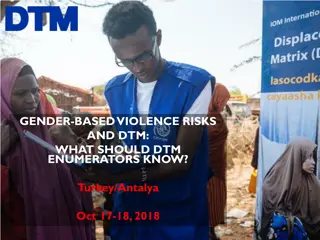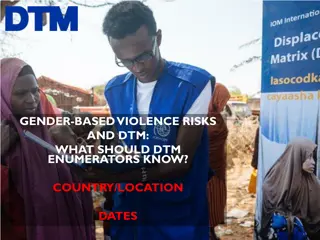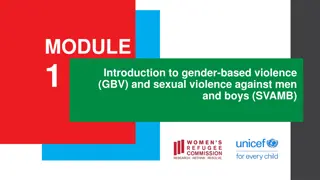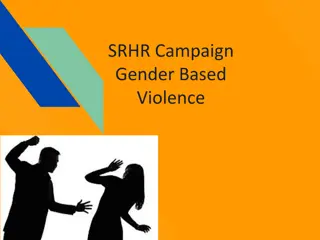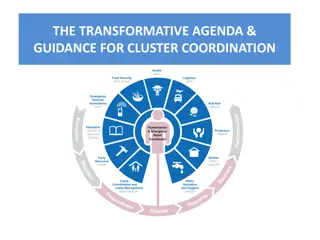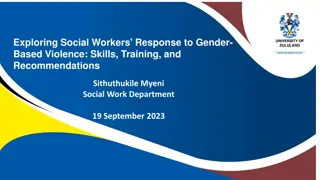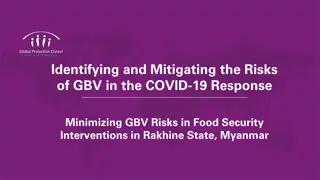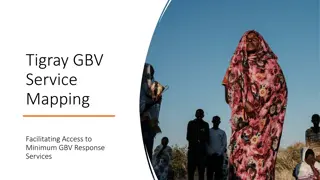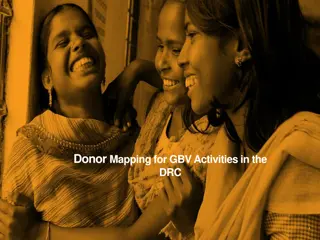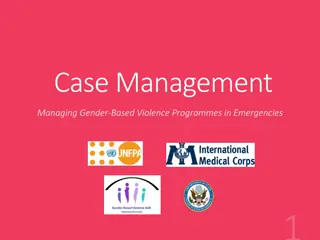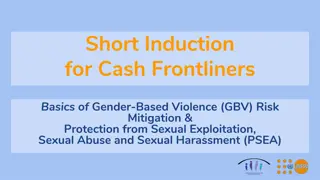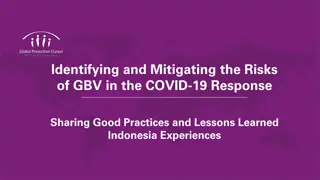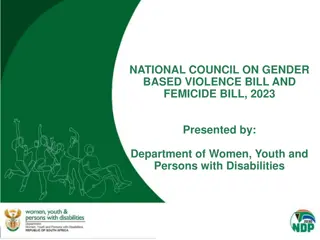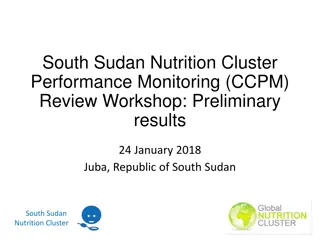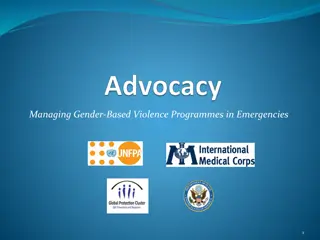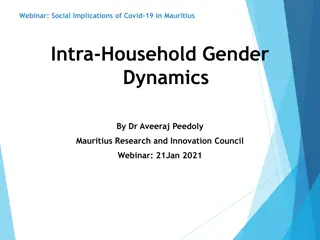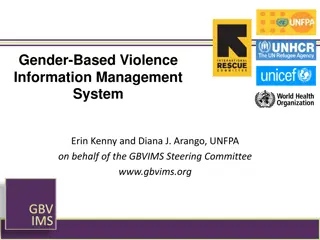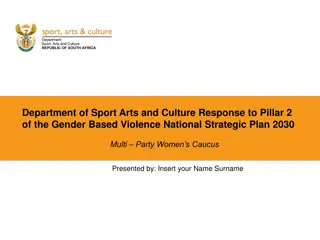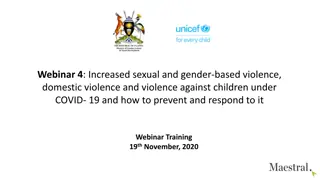Guidelines for Media Reporting on Gender-Based Violence: Roles and Functions of GBV Sub-Cluster
Comprehensive guidelines for media reporting on Gender-Based Violence (GBV) covering the roles and responsibilities of the GBV Sub-Cluster, the coordination structure, functions of the GBV Sub-Cluster, and basic concepts of GBV including different forms of violence. The document emphasizes the importance of service delivery, strategic programming, advocacy, prevention, capacity building, and monitoring in addressing GBV effectively.
Download Presentation

Please find below an Image/Link to download the presentation.
The content on the website is provided AS IS for your information and personal use only. It may not be sold, licensed, or shared on other websites without obtaining consent from the author. Download presentation by click this link. If you encounter any issues during the download, it is possible that the publisher has removed the file from their server.
E N D
Presentation Transcript
Guidelines for Media Reporting on Gender- Based Violence
GBV Sub cluster One of the Areas of Responsibilities AoR under Protection cluster - global and country level humanitarian Architecture Lead coordinating mechanism for all GBV related humanitarian Action Promotes and coordinates inter Agency and multisector partners for prevention and response to GBV Led by UNFPA and Co-lead by IRC since July 2017 About 200 GBV partners, only 15% with concrete programs Technical Reference Groups Health, PSS & Case management, Caring for Child survivors, Rule of Law, Prevention of GBV, Alternative Fuel South Sudan GBV Sub-Cluster Coordination Structure updated Feb 2020 Ministry of Gender / ARC UNICEF / IMC UNFPA / IRC Ministry of Gender / TOCH Malakal Bentiu UNICEF / IMC (ARC Focal point) Ulang Aweil Kuajok Ministry of Gender / HLSS Wau UNFPA / IMC Bor Ministry of Gender / VoP Rumbek Pibor Ministry of Gender / ARC Ministry of Gender / WAV Mundri Juba Kapoeta Maridi Yambio Ministry of Gender / World Vision Torit Ministry of Gender / HLSS Ministry of Gender / AYA Kajo-Keji Ministry of Gender / IsraAid IRC - POC 1 ARC Focal point Ministry of Gender / IsraAid
Functions of the GBV SC 1. support service delivery o Service mapping, SOPs, Referral pathways, IEC materials etc 2. Promote strategic direction of GBV programming o Needs assessment to inform programming; on going data collection, Developing an information system for coordination Making appeals for GBV funding 3. Advocacy including working with media 4. Support GBV primary prevention and risk mitigation including GBV mainstreaming 5. Conduct Capacity building to GBV partners, other clusters, media etc 6. Monitoring and evaluation of GBV programing in country
Basic Concepts of GBV GBV is an umbrella term for any harmful act that is perpetrated against a person s will and is based on socially ascribed (i.e. gender) differences between males and females. It includes acts that inflict physical, mental or sexual harm or suffering, threats of such acts, coercion and other deprivations of liberty Gender based violence can be categorized as: o Physical violence o Sexual violence o Psychological/ emotional violence o Harmful traditional practices and o Socio-economic Violence
Basic Concepts of GBV Emotional consequences Socio-economic consequences Health consequences Rejection from family Family breakdown Social rejection and isolation Social stigma Losses in women's earning potential Etc Mental health problems Suicidal thoughts and behaviour Shame, Insecurity, self- hate, self-blame Depression, Anxiety, Fear and anger Etc a) Fatal Death and suicide b) Non-fatal - STI including HIV/AIDS, Unwanted / early pregnancy, Serious injuries disability, Fistula etc.
Survivors Best Interests All efforts to document GBV for the purposes of media reporting must first prioritize survivors safety and best interests. Survivor s best interest must take precedence over other objectives, including drawing attention to particularly grave GBV violations, such as mass rape. When media reporting fails to take into account basic ethical and safety principles, it can put GBV survivors, their families and those who are helping them at risk. l
Timing matters - Access to lifesaving response services Following being raped, a survivor requires lifesaving healthcare and other services for a period of time. If a survivor feels like s/he will be identified or punished in some way because of social stigma and other factors as a consequence of being raped, s/he may not come forward to access life-saving help Media and other non-treatment related interviews can add to his/her distress and discomfort about coming forward to seek help. Therefore, such interviews are not the first priority in at least one month post incidence
Avoid judgmental language Writing about a survivor s history, her/his sexual practices or sexual orientation, what she/he was wearing, where she/he was, what she/he was doing, or what time of day the abuse occurred is victim blaming. GBV should not be presented as normal or part of the culture of the crisis-affected context. Survivor and perpetrator ethnicities should not be reported. Avoid using the term alleged rape or sexual assault or referring to a survivor as an accuser - could reinforce disbelief that a crime actually occurred and has the potential to reinforce negative stereotypes.
Never report details that could put survivors at further risk Names, photographs, or other identifying information of survivors, their family members, or even at times those actors who are providing assistance (depending on the context), should not be used. Any breaches to this best practice can put survivors lives at risk. Since the name of the survivor or any other identifying information must be changed in the story, there is no need to write names down.
Use of images, footage and photographs Photos should not include any identifiable information. Any use of images should present the subject in a way that upholds dignity. Where possible, images should be used to illustrate a general situation, rather than a specific incident of GBV. It is not recommended to take pictures of survivors. Photos of child survivors should never be used.
Impartiality Not your job to judge or discriminate. Do not mention details that can be interpreted as blame on the survivor. Do not mention clothes worn at the time of an attack or other aspects of a survivor/victim s appearance - implies judgment of them. Particularly true when writing features: some journalists may attempt to add detail and colour which can unintentionally shift the focus of blame away from the perpetrator.
Respecting Privacy Principled ethical journalism means respecting the privacy of both gender- based violence survivors and their families. Be wary of jigsaw identification when granting anonymity. This happens where audiences can piece together details - such as location age clothing or family members - even though journalists don t name the survivor or show their face.
WHO Ethical & Safety Recommendation: Benefits of documenting Sexual Violence must be greater than the risks Do no Harm Methodologies should be grounded in best practices. Ensure availability of minimum care & support for survivors Safety & security respondents, participants and staff Protect the confidentiality of survivors, respondents, participants Informed consent Training and ongoing support for staff Safeguards must be in place for children to be involved in information gathering of survivors,
Survivor Centered approach Survivor-centred approach: A survivor-centred approach creates a supportive environment in which the survivor s rights and wishes are respected, their safety is ensured, and they are treated with dignity and respect. A survivor-centred approach is based on the following guiding principles 15
Guiding Principles of Working with a GBV Survivor The guiding principles on GBV were established to ensure that key actors who are working to prevent and respond to GBV ensure no further harm comes to survivors or the community as they request for help. 16
Main guiding principles 1. RESPECT 2. CONFIDENTIALITY 3. SAFETY AND SECURITY 4. NON DISCRIMINATION 17
GBV guiding principles Safety: Safety and security of survivor, family and those who assisted her must be the number one priority for all actors including journalists Confidentiality: Not disclosing any information at any time to any party without the informed consent of the person concerned. Respect: All actions taken will be guided by respect for the choices, wishes, rights, and dignity of the survivor. Non discrimination: Survivors of violence should receive equal and fair treatment regardless of their age, race, religion, nationality
1. RESPECT: Appreciating and valuing the person and his or her experiences, ideas, decisions and actions HOW DO YOU SHOW RESPECT TO A PERSON (SURVIVOR)? 19
Respect cont You can respect the survivor by: Conducting interviews in private settings Conducting interviews and examinations by staff of the same sex as the survivor Being a good listener Maintaining a non-judgemental manner concerning the survivor and her or his behavior Being patient 20
Respect cont If and when possible, not asking the survivor for more information if he or she is not ready to speak about the incident Asking only relevant questions 21
Respect cont Not discussing the survivor s previous sexual history Avoiding asking the survivor to repeat her or his story in multiple interviews Not laughing or showing any disrespect for the survivor and her or his culture, family or situation 22
Respect cont Think about a time when you were not respected. How did you feel? 23
CONFIDENTIALITY This means that information will be shared ONLY with others who need to know about the case in order to provide assistance and intervention, as requested and agreed to by the survivor. ROLE PLAY Confidentiality 24
Confidentiality cont If confidentiality is breached it could bring grave consequences for the survivor, particularly if adequate protection is not in place. It also may discourage other survivors from coming forward 25
Confidentiality cont If confidentiality is breached, there can be; Threats to the survivor, the perpetrator and/or the GBV worker Injury to the survivor, the perpetrator and/or the GBV worker Death of the survivor, the perpetrator and/or the GBV worker 26
Breaching Confidentiality The ONLY TIME confidentiality should be breached is when there is imminent risk to the survivor or the GBV worker e.g. threats of violence, death threats 27
Safety and security At all times, you MUST make sure the survivor is safe. The safety of the survivor must remain paramount in your work 28
How can you make sure that the survivor is safe and secure? Keep all information confidential Relocate survivor if possible Report all threats to relevant authorities 29
NON DISCRIMINATION EVERYONE seeking GBV services should access the service if available 30
Conduct research before interviewing This session has been covered The interview process should begin with research It is important to do background research on GBV in order to develop a news story. There is ample factual information readily available on gender-based violence on the internet do the research before asking GBV experts to do it for you GBV Experts can guide media to ensure that story presented in way so as to not increase the risk of further abuse or retribution against survivors, their families, or others who are helping them get care.
Local support services and organizations who are addressing GBV in the context. Include contact information of local support services so survivors/witnesses, their families and others who may have experienced or been affected by GBV to access the care they need. Critical to obtain consent of service providers prior to printing or broadcasting information on services.
. What are the take away messages while producing a GBV content?
Things to think about while producing GBV content Have you protected your sources/interviewees? Have you made sure that there will be no negative repercussions from your interaction with a GBV survivor? Have you been specific in your terminology, and avoided vague or ambiguous euphemisms? For example, The guard molested her has a different meaning from the guard raped her. (This is because terms like molest, and sexual activity are vague, while rape is a specific crime that tells us what happened). Have you avoided prejudicial descriptions of the victim? For example, She was walking alone at the time of the attack (this description is not relevant, and could imply judgment of the person who has suffered from an attack). A woman may not report a GBV incident for fear of reprisals from her attacker, because she was disorientated following her trauma, or because of inadequate legal systems. Lack of immediate reporting does not imply she has made up the incident).


